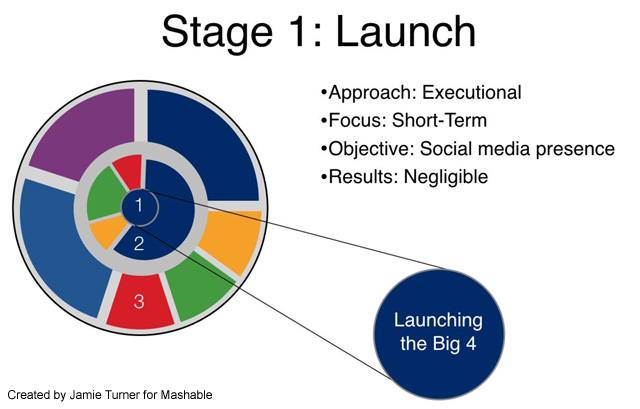 Jamie Turner is the chief content officer of the 60 Second Marketer, the online magazine for BKV Digital and Direct Response. He is also the co-author of How to Make Money with Social Media. He’ll be speaking about his Social Media ROI Cycle at the SXSW Conference in Austin on March 15.
Jamie Turner is the chief content officer of the 60 Second Marketer, the online magazine for BKV Digital and Direct Response. He is also the co-author of How to Make Money with Social Media. He’ll be speaking about his Social Media ROI Cycle at the SXSW Conference in Austin on March 15.
Not long ago, I wrote about how to calculate the ROI of your social media campaign, which generated a lot of interest from the social media community. The article outlined how businesses can use Customer Lifetime Value to calculate the return on their social media investment.
After writing the article, I started analyzing how businesses go about setting up, launching and running their social media campaigns. My conclusion is that there are three distinct stages to this process, which I’m calling the Social Media ROI Cycle. My rough estimate is that about 50% of the business community is still in the Launch stage, about 40% is in the Management stage and about 10% is in the Optimization stage.
Each one of the three stages has its own nuances, so let’s take a look at what happens during each. The percentages referenced in each stage are estimates based on my own experience.
Stage 1: Launch
During the Launch stage, 100% of a company’s focus is on setting up the big four: LinkedIn, Facebook, Twitterand YouTube. Some companies focus on the big four plus more such as Flickr, e-newsletters, blogs,SlideShare and other social media platforms. But most companies kick things off by quickly getting into the big four networks simply as a way to have a social media presence.
The approach during this Launch stage is very executional with very little long-term planning. The primary objective is simply to get started. After all, those in charge want to ensure the brand is utilizing cutting-edge techniques, so the marketing department typically responds by jumping in without much plan for the long haul.
Unfortunately, the results of the Stage 1 process are negligible. Sure, you’ll be able to claim that you’ve “got a social media campaign,” but you won’t really see much traction unless you move on to Stage 2.
Stage 2: Management
During this stage, roughly 60% of a company’s efforts are focused on the big four (or the big four plus more). About 10% of the focus is on creative and offer development, 20% on tracking quantitative metrics such as traffic, inbound links, Facebook “Likes,” etc., and about 10% on qualitative metrics such as brand sentiment, survey results and customer polls.
The approach during the Management stage is still very tactical, but the focus is on mid-term instead of short-term results, which is an improvement over Stage 1. The corporate objective at this stage is to engage prospects and customers in some way that gets them to connect with the brand. Ideally, this would mean buying something, but it can also mean downloading a white paper, liking a Facebook Page, responding to a survey, or any other measurable evidence that they’re connecting with your brand.
Stage 2 is where many of the more sophisticated companies find themselves right now. They’re managing their social presence, testing creative ideas, tracking quantitative metrics and analyzing qualitative data.
Most companies today are still at either Stage 1 or Stage 2. But many of the companies I work with have started to reach the Stage 3.
Stage 3: Optimization
About 25% of the focus at this stage is on the “big four plus more,” and about 30% is evenly split among creative and offer development, quantitative metrics and qualitative metrics.
Another 25% of a company’s focus is on improving conversion and optimization of campaigns. What do I mean by that? It’s all about tracking inbound leads and traffic across social media platforms, using tools such asAtlas and DART, and watching those leads turn into customers, either on e-commerce landing pages or through B2B lead generation programs.
It also means testing your way to success with social media campaigns. This can be as simple as trying two different landing pages to see which one drives more clicks. Or, it can be as complex as multivariate testing that analyzes more than one component at a time.
The final 20% of a company’s efforts in Stage 3 include measuring the success of the campaign on an ROI basis. And yes, you can measure a social media campaign on an ROI basis, despite what some social media “experts” will tell you.
The process involves understanding your Customer Lifetime Value (the total revenue the average customer generates for your business during the lifetime of their engagement with you) and comparing it to the results generated by your social media campaign.
For example, if you know the typical customer spends $10 per month with your company and stays loyal to your brand for an average of three years, your Customer Lifetime Value is $360.
Many companies are comfortable spending 10% of their CLV to acquire a new customer. So, in other words, they’ll spend $36 to acquire a new customer who will spend $360 during his or her engagement with the brand.
If your social media campaign costs, say, $36,000 a year to run, and it generates 1,000 new customers each year, you’ve got a winner on your hands. (For a more detailed explanation of this process, please see my previous post, HOW TO: Calculate the ROI of Your Social Media Campaign.)
The Bottom Line
In the end, all roads should lead to social media ROI. After all, businesses don’t do social media to be social, they do social media to grow sales and revenues.
If you carefully navigate your way through Stage 1, Stage 2 and Stage 3, you’ll eventually be able to go up to your CFO and say, “Hey, Chief Financial Dude, remember when you told me we wouldn’t be able to measure the ROI of our social media campaigns? Well, we’re already doing it, and we’re making a profit, you knucklehead. So there!”
Of course, you don’t have to use those exact words, but you get my point.



